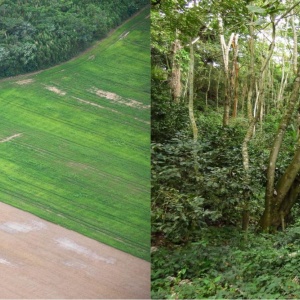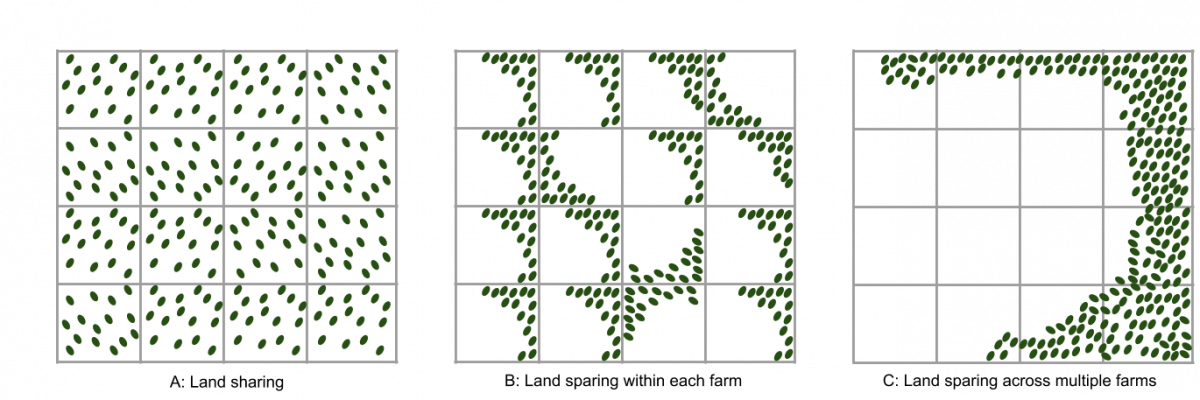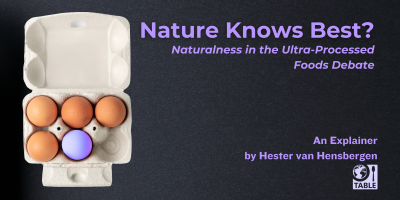

Agricultural production is responsible for the majority of global land use. The use of land to produce food almost always comes into conflict with goals for the conservation of nature and wildlife.
This building block explains the land sparing-sharing continuum, which encompasses two fundamentally different approaches to balancing goals for food production and biodiversity conservation.
Last update: 14 August, 2018
https://www.doi.org/10.56661/4d83249aA shorter written version of this summary is available here.
Definitions
Land sparing: is the principle of segregating land for nature conservation from land for food (or agricultural) production within a region. It consists of high-yielding farmland with relatively lower biodiversity, with the remaining land being spared for nature conservation. Land sparing sits at one end of the two extremes of the land sparing-sharing continuum. It has in particular been criticised for its (supposed) connection to environmentally unsustainable intensive agriculture and for undermining the food security of smallholder farmers and rural economies.
Land sharing: is the principle of integrating nature conservation approaches into agricultural production across a region. Its characteristics are that of low-yielding farmland with higher biodiversity, but with less land available for the sole purpose of nature conservation. Land sharing sits at one end of the two extremes of the land sparing-sharing continuum. It has in particular been criticised for leading to lower levels of biodiversity on a regional scale and for a tendency for generalist species to thrive at the expense of specialist or endemic species.
Wildlife-friendly farming: while this is a fairly informal term, it generally refers to an approach to farming that aims to support both food production and the conservation of biodiversity on farmland. Wildlife-friendly farming is associated with the use of reduced chemical and fertiliser inputs and the preservation of native vegetation (e.g. flowers, trees, and bushes) on or around farmland. Those who use the term tend to equate wildlife-friendly farming with a land sharing approach. Related although not synonymous terms include organic farming and agroecology.
Agricultural Intensification: is the process of increasing inputs of agricultural resources (e.g. seeds, labour, fertilisers, pesticides, technologies, knowledge) to increase the level of yield per unit of farmland or pasture. Agricultural intensification is not always clearly or consistently defined and is often confused with the term intensive agriculture. Unlike intensive agriculture, which is an agricultural approach, agricultural intensification is a general process that can apply, in principle, to any type of agricultural production. Examples of agricultural intensification may range from using new pesticides in intensive agriculture to intensifying the use of indigenous and context-specific knowledge in local farming practices. Although agricultural intensification can take many forms, it always involves the intensification of some types of agricultural input in order to increase levels of yields.
Intensive agriculture (IA). Often used synonymously with the terms industrial agriculture and conventional farming, IA is generally used to denote farming systems that use modern technologies and economies of scale to maximise yields relative to land use and production costs (e.g. costs of labour, technology, seeds, fertilisers, and pesticides). IA is associated with high use of chemical fertilisers, agrochemicals, and irrigation. This combination of agricultural technologies became common during the Green Revolution in the mid-20th century, and has long been criticized for its high social and environmental impacts.
Explanation
1. Introduction
2. What are land sparing and land sharing?
3. Sparing, sharing or something in between: what are the implications for biodiversity?
4. Criticisms of land sparing and land sharing
4.1 Food production or food security?
4.2 Farming techniques or yield levels?
4.3 Implications of land use change
5. Land sparing-sharing addresses some, not all, questions
1. Introduction
Agricultural landscapes now span 38% of the world’s (ice-free) land surface, with around 12% covered by crops and 26% covered by pastures. The implication of this is that agriculture is an important cause of habitat loss, and that a large variety of wildlife is forced to share land with food production1 .
The concepts of land sparing and land sharing originate from a lively and polarized debate between ecologists about how best to integrate agricultural production within a landscape, at the least possible cost to biodiversity 1 ,2 . The two are stylised endpoints of a continuum of possible land use strategies; their merits and demerits are subject to much debate both as to which is preferable but also as regards the overall utility of these concepts as a tool for decision-making in the context of a complex and messy set of food system concerns and priorities.
2. What are land sparing and land sharing?
Debate on land sparing and land sharing was sparked around 2005 by conservation biologists from the University of Cambridge1 ,3 . They recognised that there is usually a limit to the extent to which farmland can be made 'wildlife friendly' without compromising yields1 . Accordingly, they reasoned, efforts to improve on-farm biodiversity could potentially backfire on biodiversity at a larger spatial scale, as more farmland might be needed to produce a given amount of food1 . This led them to define and compare land sparing and land sharing as two radically opposing land use strategies.
In principle, a land-sparing scenario (figure 1b and c) is one in which farmland is higher yielding (and therefore often less biodiverse), but since high farm productivity means that less land is needed to achieve a given level of output, this could allow more non-farm land to be spared for nature. In a land sharing scenario (figure 1a), farmland is less high yielding (measured in terms of, say, cereal output) but more biodiverse. However, for the same level of food output, as compared with a land sparing scenario, less land is available solely for nature conservation.

Figure 1: The three figures (a, b, and c) show the same surface area (roughly several to hundreds of square kilometres4 ,5 ), organized according to land sharing (a), and land sparing at a farm-level (b) and land sparing at an area-level (c). Each area has a similar ratio of agriculture/wildlife land (white/green) and has distinct characteristics for biodiversity conservation and food production. Reproduced from Balmford et al., 20126 .
Land sparing and land sharing (see figure 2) are stylised versions of the choices theoretically available to land managers. In reality, managers will make decisions about land use on the basis of many other factors as well, with economic considerations usually carrying the most weight7 ,8 . Faced with real life limitations and priorities that go beyond biodiversity, those engaging in the debate also adopt more context specific positions.

Figure 2: On the left, an example of land sparing in Bolivia where farmland and land for nature conservation are segregated. On the right, an example of land sharing on a shade-grown coffee plantation in Mexico, where food production is integrated into native vegetation.
3. Sparing, sharing or something in between: what are the implications for biodiversity?
In practice, most current landscapes are not exemplars of the extremes of the land sparing-sharing continuum, but rather represent mixed and intermediate scenarios. An intermediate scenario might involve protecting some native vegetation that allows some more species to persist on-farm, while accepting a somewhat lower yield (e.g. arable field margins). A mixed scenario might involve an area spared for nature conservation, and some low-yielding farmland (e.g. conservation grazing ), alongside a smaller area of high-yielding farmland.
Whether biodiversity is least affected and best supported by land sparing, land sharing or something in between depends on many factors, including the range and types of species that are present, features of the landscape such as topography, climate and the history of land use, the farming techniques used, and the types of crops or livestock that are farmed. A further complication is the fact that biodiversity can be understood and measured in many ways – for example as the number of different species that are present in an area (species richness), but also as the size and viability of species populations (species abundance). Crucially, people have different values and opinions as to which species (e.g. endemic species or those that fulfil important functions such as pollination) should be prioritised in biodiversity conservation efforts9 . Different judgements can be based upon many things including different scientific or lay arguments and perspectives on human-nature relationships. This complexity makes it difficult to draw generic conclusions about which land use strategy would in theory be optimal in what context.
Most empirical studies that compare land sparing and land sharing have been undertaken by conservation biologists from the University of Cambridge (see the video below). These studies rely on data about the densities of specific wild species across a gradient of agricultural yields, from unfarmed land to high-yielding farmland. These data are used to develop density-yield curves (figure 3), which illustrate whether a species would have larger populations in land sparing or land sharing.
Notably, while the various studies that compare sparing and sharing, focus on very different types of landscapes (e.g. tropical forests or European farmland), they nevertheless reach very similar conclusions. Some species (so-called ‘winners’) occur at higher densities in farmland than in their natural, zero-yielding habitat (figure 3a and b). However, the populations of the majority of species (so-called ‘losers’) decline when their habitats are converted to farmland (figure 3c and d). Many loser species are often considered to be of the greatest relevance to conservation efforts; most of them will be less heavily affected by land sparing than by land sharing4 . These conclusions hold especially for specialist and endemic which only thrive in a small range of environmental conditions and which are most greatly and negatively affected by the conversion of wild land to farmland4 .

A general observation from these studies is that, in the landscapes under consideration, land sparing would support viable populations of more species than land sharing3 ,5 ,7 ,10 ,11 ,12 . This gives rise to a twofold conclusion. First, if agricultural production is to rise either at the global or local level (the need for such an increase is debated – see below), then it would be less harmful for biodiversity if this were to follow the route of increasing yields rather than through further conversion of wild areas to farmland. And second, in order to ensure that land sparing does in fact occur (see below), there is a need to establish and/or enforce protected areas for endangered species.
4. Criticisms of land sparing and land sharing
The land sparing-sharing perspective has been criticised for being too narrow and simplistic a way of looking at potentially optimal land use strategies9 ,13 ,14 . Critics point out that it is unhelpful to consider theoretical possibilities when in practice many other factors need thinking about as well; once these are considered together a different picture arises, one that favours not land sparing but rather land sharing and/or intermediate or mixed scenarios. Advocates of a sparing perspective counter these criticisms on the grounds that they are based on fundamental misunderstandings of the purpose and scope of the land sparing-sharing perspective4 .
Important points of controversy and debate include the following:
4.1 Food production or food security?
The land sparing-sharing literature has been criticised for focusing on food production rather than on food security9 ,15 (see our building block on food security). Critics point out that there is currently already enough food to feed everyone, yet millions of people go hungry and many more are malnourished (see our building block on malnutrition) as roughly one third of all food is wasted while another third is used to feed livestock15 . They say there is no need to increase food production and thus no need for more or higher-yielding farmland. As a consequence, they argue, efforts to improve on-farm biodiversity are not necessarily in conflict with protecting (or even expanding) nature conservation areas16 .
In addition, critics of the sparing-sharing framing especially emphasise the point that a major part of all food is produced by smallholder farmers and rural populations, who often live in severe conditions of food insecurity15 ,16 . Their food security (and ultimately their well-being) would not be improved by simply producing more food and may even be undermined when high-yielding farming approaches are favourable to large landowners (see below). Rather than more food, the food security of rural populations would increase as a result of improved socio-economic and physical access to food of sufficient quantity, diversity, and quality to satisfy the need for a safe and healthy diet. Agroecological farming practices that involve high crop diversity (e.g. intercropping ) are thought to be promising in this respect: they make a nutritionally diverse range of foods locally accessible, while also supporting (on-farm) biodiversity conservation15 ,16 ,17 . In addition, some also argue that ‘land sharing’ landscapes would not only improve rural populations’ food security, but also improve their access to other ecosystem services that are paramount to their well-being, such as drinking water and firewood18 .
These criticisms have in their turn been countered by those generally favouring a sparing approach4 . On the multidimensionality of food security and the need to support rural populations, they stress that there is no disagreement here. Comparisons between land sparing and sharing however focus on food production rather than food security per se since it is this that threatens wild species and their habitats4 . Proponents of land sparing say that because food production continues to rise (whether we like it or not), it is necessary to identify the ‘least bad’ way of managing the effects on biodiversity. And if current consumption trajectories become less resource demanding and global food production levels off, then a high yielding approach could in principle allow land currently used for food growing to be released back to nature. They also emphasise that land sparing landscapes also provide many other ecosystem services (including drinking water, flood protection, and carbon sequestration ) that are of value, in addition to biodiversity, and that higher yields can be achieved by supporting and empowering smallholder farmers4 .
4.2 Farming techniques or yield levels?
Some opponents of land sparing have interpreted land sparing and land sharing as roughly corresponding to intensive agriculture and organic agriculture or agroforestry respectively19 . It is argued that because productivity gains have been and still are generally achieved through high use of synthetic fertilisers, pesticides, and irrigation, the on- and off-farm environmental impacts of land sparing are overall much greater than those of the organic and agroecological techniques which are associated with land sharing. In addition, it is thought that land sparing generally involves the use of much more expensive farming techniques that are unaffordable to smallholders and may displace traditional livelihoods and cultures15 .
As to the affordability of yield-increasing agricultural techniques, advocates of land sparing point out that neither land sparing nor land sharing a priori favours any one form of agronomy over another. Measures to increase on-farm productivity need not rely on expensive technologies, and approaches such as intercropping or crop rotations are likewise highlighted as low-cost ways of improving yields4 ,6 . In addition, advocates of land sparing underscore the need for alternatives to business-as-usual forms of intensive agriculture, specifically agricultural approaches (which may include the greater use of agroecological and agronomic knowledge) that increase yields while reducing agriculture’s overall environmental impacts (see our building block on sustainable intensification)4 . Accordingly, they also agree that agroecological farming methods (such as intercropping) are favourable in situations where they lead to high yields with rich biodiversity on-farm4 .
In principle, there are many ways to increase yield, but if, how, to what extent and at what environmental cost yield-increases can be achieved ultimately depends on the baseline situation. For example, in contexts where yields are already high, any marginal yield increases that could be achieved may arguably not be ‘worth’ the unacceptably high environmental cost of so doing. On the other hand, measures to address land degradation (for example) in low-income countries - where yields are generally lower - may not only result in environmental improvements but also improve yields. The land sparing-sharing perspective does of itself not tell us which form of agricultural intensification (e.g. adding some more fertiliser or applying certain agronomic knowledge) would be appropriate in a specific situation.
4.3 Implications of land use change
The knock-on implications of different land use strategies at a local level on overall land use decisions at a broader, even international level, also need to be considered (read our building block on land use change). Land sharing could, for example, be an unfavourable strategy where its practice in one location inadvertently leads to an overall expansion of global agriculture’s land footprint to make up for the shortfall in overall output (see our building block on sustainable intensification)20 .
On the other hand, higher crop yields and more cost-efficient production in a land sparing scenario may not actually deliver the intended sparing effect when land controls are absent or inadequate. Where higher yields lead to higher profits, farmers may simply be incentivised to further expand their farmed area (an outcome known as Jevon’s Paradox). Equally, if cost savings achieved through higher efficiencies in production are passed on to consumers in the form of lower food prices, consumers may respond by buying more, stimulating increases in production to meet the new level of demand. The risk, then, is that efficiency gains in food production lead to overall increases in demand and supply, and result in less, not more, land being spared for nature conservation21 ,22 . However, an in-between scenario may also be envisaged: Land sparing could be moderately effective when dampening, rather than entirely countering on the one hand, or exacerbating on the other, the expansion of the agricultural footprint. There is some research to suggest that this in practice is what has actually happened to date4 .
Essential to note is that both critics and proponents of land sparing agree that adequate governance and enforcement is necessary to ensure that land, particularly areas that are critical to biodiversity conservation, is being spared for nature8 ,23 .
5. Land sparing-sharing addresses some, not all, questions
The land sparing-sharing literature has been characterised as addressing an important subset of questions on food, land use and conservation, without addressing other core questions in this field4 . The most important conclusion of the empirical research on land sparing and sharing is that most species, in particular specialist species , are in theory best protected via a land sparing strategy. This point is however theoretical, given the real and messy practicalities of decision-making around land, and serves to underscore first and foremost the need for establishing and effectively protecting dedicated areas for nature conservation – a point on which all conservationists agree.
That said, while both critics and supporters of the land sparing-sharing continuum concur that protected areas are needed, they disagree about the practical utility of measuring food production and biodiversity conservation exclusively and without taking account of the broader, and more complex picture. Some try to move beyond the sparing-sharing perspective, while others emphasise that understanding the impacts of different forms of food production on biodiversity remains crucial for effective biodiversity conservation.
Download the PDF version of this explainer here.
Footnotes
- 1 a b c d e Green, R. E., Cornell, S. J., Scharlemann, J. P. W. & Balmford, A. Farming and the Fate of Wild Nature. Science 307, 550–555 (2005).
- 2Balmford, A., Green, R. E. & Scharlemann, J. P. W. Sparing land for nature: exploring the potential impact of changes in agricultural yield on the area needed for crop production. Global Change Biology 11, 1594–1605 (2005).
- 3 a b c Phalan, B., Onial, M., Balmford, A. & Green, R. E. Reconciling Food Production and Biodiversity Conservation: Land Sharing and Land Sparing Compared. Science 333, 1289–1291 (2011).
- 4 a b c d e f g h i j k l Phalan, B. T. What Have We Learned from the Land Sparing-sharing Model? Sustainability 10, 1760 (2018).
- 5 a b Balmford, A., Green, R. & Phalan, B. Land for Food & Land for Nature? Daedalus 144, 57–75 (2015).
- 6 a b Balmford, A., Green, R. & Phalan, B. What conservationists need to know about farming. Proc. R. Soc. B rspb20120515 (2012). doi:10.1098/rspb.2012.0515
- 7 a b Hodgson, J. A., Kunin, W. E., Thomas, C. D., Benton, T. G. & Gabriel, D. Comparing organic farming and land sparing: optimizing yield and butterfly populations at a landscape scale. Ecology Letters 13, 1358–1367 (2010).
- 8 a b Phalan, B. et al. How can higher-yield farming help to spare nature? Science 351, 450–451 (2016).
- 9 a b c Fischer, J. et al. Land Sparing Versus Land Sharing: Moving Forward. Conservation Letters 7, 149–157 (2014).
- 10Edwards, D. P. et al. Land‐sharing versus land‐sparing logging: reconciling timber extraction with biodiversity conservation. Global Change Biology 20, 183–191 (2014).
- 11Hulme, M. F. et al. Conserving the Birds of Uganda’s Banana-Coffee Arc: Land Sparing and Land Sharing Compared. PLOS ONE 8, e54597 (2013).
- 12Williams David R et al. Land‐use strategies to balance livestock production, biodiversity conservation and carbon storage in Yucatán, Mexico. Global Change Biology 23, 5260–5272 (2017).
- 13Bennett, E. M. Changing the agriculture and environment conversation. Nature Ecology & Evolution (2017). doi:10.1038/s41559-016-0018
- 14Meyfroidt, P. Trade-offs between environment and livelihoods: Bridging the global land use and food security discussions. Global Food Security (2017). doi:10.1016/j.gfs.2017.08.001
- 15 a b c d e Tscharntke, T. et al. Global food security, biodiversity conservation and the future of agricultural intensification . Biological Conservation 151, 53–59 (2012).
- 16 a b c Fischer, J. et al. Reframing the Food–Biodiversity Challenge. Trends in Ecology & Evolution 32, 335–345 (2017).
- 17Kremen, C. Reframing the land-sparing/land-sharing debate for biodiversity conservation. Ann. N.Y. Acad. Sci. 1355, 52–76 (2015).
- 18Fischer, J., Meacham, M. & Queiroz, C. A plea for multifunctional landscapes. Frontiers in Ecology and the Environment 15, 59–59 (2017).
- 19Fischer, J. et al. Should agricultural policies encourage land sparing or wildlife-friendly farming ? Frontiers in Ecology and the Environment 6, 380–385 (2008).
- 20Garnett, T. & Godfray, H. C. J. Sustainable intensification in agriculture. Navigating a course through competing food system priorities. (Food Climate Research Network and the Oxford Martin Programme on the Future of Food, University of Oxford, 2012).
- 21Salles, J.-M., Teillard, F., Tichit, M. & Zanella, M. Land sparing versus land sharing: an economist’s perspective. Reg Environ Change 17, 1455–1465 (2017).
- 22Byerlee, D., Stevenson, J. & Villoria, N. Does intensification slow crop land expansion or encourage deforestation ? Global Food Security 3, 92–98 (2014).
- 23Fischer, J. et al. Conservation: Limits of Land Sparing. Science 334, 593–593 (2011).
Recommended resources
Review article (open access): What Have We Learned from the Land Sparing-sharing Model?
Review article (paywall): Reframing the land-sparing/land-sharing debate for biodiversity conservation
Review article (open access): Land Sparing Versus Land Sharing: Moving Forward
Review article (paywall): Global food security, biodiversity conservation and the future of agricultural intensification
Research article (open access): What conservationists need to know about farming
FCRN forum discussion: Land-sharing vs. land-sparing debate – moving towards a more constructive conversation about agriculture and the environment?
Acknowledgements
Suggested citation
Fraanje, W. (2018). What is the land sparing-sharing continuum? (Foodsource: building blocks). Food Climate Research Network, University of Oxford.
Written by
Walter Fraanje, Food and Climate Research Network, University of Oxford
Edited by
Tara Garnett, Food Climate Research Network, University of Oxford
Sam Lee-Gammage, Food Climate Research Network, University of Oxford
Reviewed by
Andrew Balmford, Department of Zoology at the University of Cambridge
Tim Benton, School of Biology at the University of Leeds and Energy Environment and Resources at Chatham House
Joern Fischer, Institute for Ecology at the Leuphana University of Lüneburg
Ben Phalan, Department of Zoology at the University of Cambridge
Reviewing does not constitute an endorsement. Final editorial decisions, including any remaining inaccuracies and errors, are the sole responsibility of the Food Climate Research Network.
Funded by
The Daniel and Nina Carasso Foundation
The Esmée Fairbairn Foundation











Post a new comment »